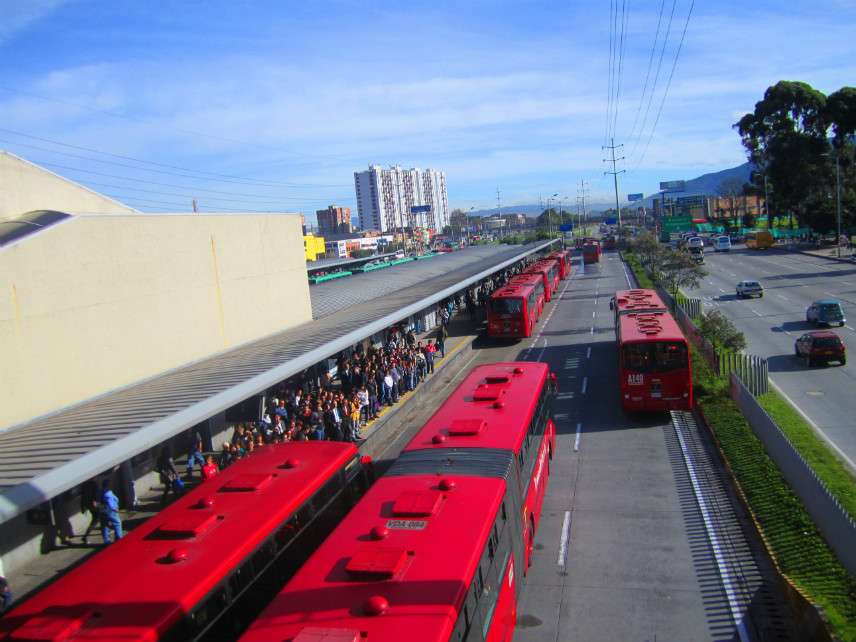Miami Politicians Do Their Level Best to Spend as Much as Humanly Possible on Transit
Politicians reject a plan to expand bus service on a bus-only road, demanding instead that a light rail line be built alongside it.

Some politicians just want to spend money, even when opportunities for savings are smacking them in the face. Witness the fight breaking out between Miami-area politicians over whether they should use light rail or Bus Rapid Transit (BRT) to extend transit service to southern Miami-Dade County.
On the face of it, BRT—basically an express bus service that uses larger vehicles to make frequent trips in dedicated lanes—sounds like a better deal. The county already maintains a bus-only roadway that would be used for any new BRT route, whereas a rail extension would require new track to be laid. A BRT line is estimated to cost $250–$300 million, while a light rail expansion servicing the same area would cost as much as $1.5 billion to build—and 80 percent more to operate. A BRT line could be finished by 2022. Light rail would take years longer.
True, the county estimates that a BRT line would carry only 25,000 people a day, compared to the 40,000 who would supposedly take the light rail. Nevertheless, BRT still works out to be the cheaper-per-passenger option.
Besides the cost, there's the flexibility. Light rail is permanent, so it will always go to the same place, even if people, homes, and jobs move elsewhere. BRT can be more responsive to changing transit patterns.
Some cities have seen great success with BRT lines. Los Angeles' Orange Line—an 18-mile BRT route that opened in 2005—exceeded ridership estimates by threefold, a true rarity in public transit. Cash-strapped locales like Mexico City and Istanbul have used BRT to build out their transit networks without breaking the bank.
All that has been enough for Mayor Carlos Gimenez to endorse BRT. But state Rep. Kionne McGhee (D–South Dade) has spent the last two years leading what he calls a "revolt" against BRT.
"People in the south understand that if they settle for a bus, they'll never get a rail. Nobody wants buses," McGhee told The Miami Herald last week. Last week he sent a letter to the U.S. Department of Transportation urging it to deny any funds to Miami-Dade County that were not earmarked for light rail. His Twitter feed features frequent and impassioned denunciations of anyone advocating transit that doesn't run on tracks.
If any 2020 mayoral candidate believes he/she can win a Mayoral Race in Miami-Dade without the support of South Dade, he/she is mistaken. If you don't support the RAIL now, I will lead the Charge in SOUTH DADE to reject you later. That's a PROMISE. @IRideMDT @MiamiDadeBCC
— Kionne McGhee (@kionnemcghee) June 25, 2018
HOW SAD: while we're here in the South Dade communities fighting for our brothers/sisters and reunification of our families, @IRideMDT+some Commissioners @MiamiDadeBCC are plotting to force more BUSES down the throats our people in the South. WE PAID FOR RAIL! #shameonyou WE C U!
— Kionne McGhee (@kionnemcghee) June 25, 2018
It isn't entirely clear why exactly McGhee and his allies prefer a vastly more expensive light rail system. Looking at the comments from pro-rail politicians going back several years, their reasoning seems to be that rail is just self-evidently better. "People don't like to take buses. Unless they have no alternative," County Commissioner Xavier Suarez told the Herald in 2016.
"I say let's go for it. If we fall short, at least we're falling short in trying to make a difference, and trying to bring enhanced transportation to this community," Commissioner Dennis Moss said last year of a plan that would prioritize light rail over BRT.
Baruch Feigenbaum, a transportation policy analyst with the Reason Foundation (the nonprofit that publishes this website), says politicians have an innate bias in favor of light rail.
"Politicians don't care about cost-benefit analysis," he says. "What they know is what they can visualize and what they can cut a ribbon on."
The county's transportation board is scheduled to vote on BRT on July 19.
Rent Free is a weekly newsletter from Christian Britschgi on urbanism and the fight for less regulation, more housing, more property rights, and more freedom in America's cities.


Show Comments (21)